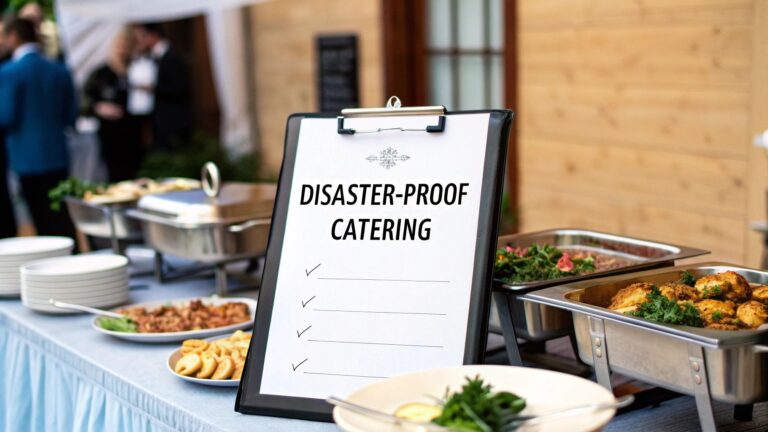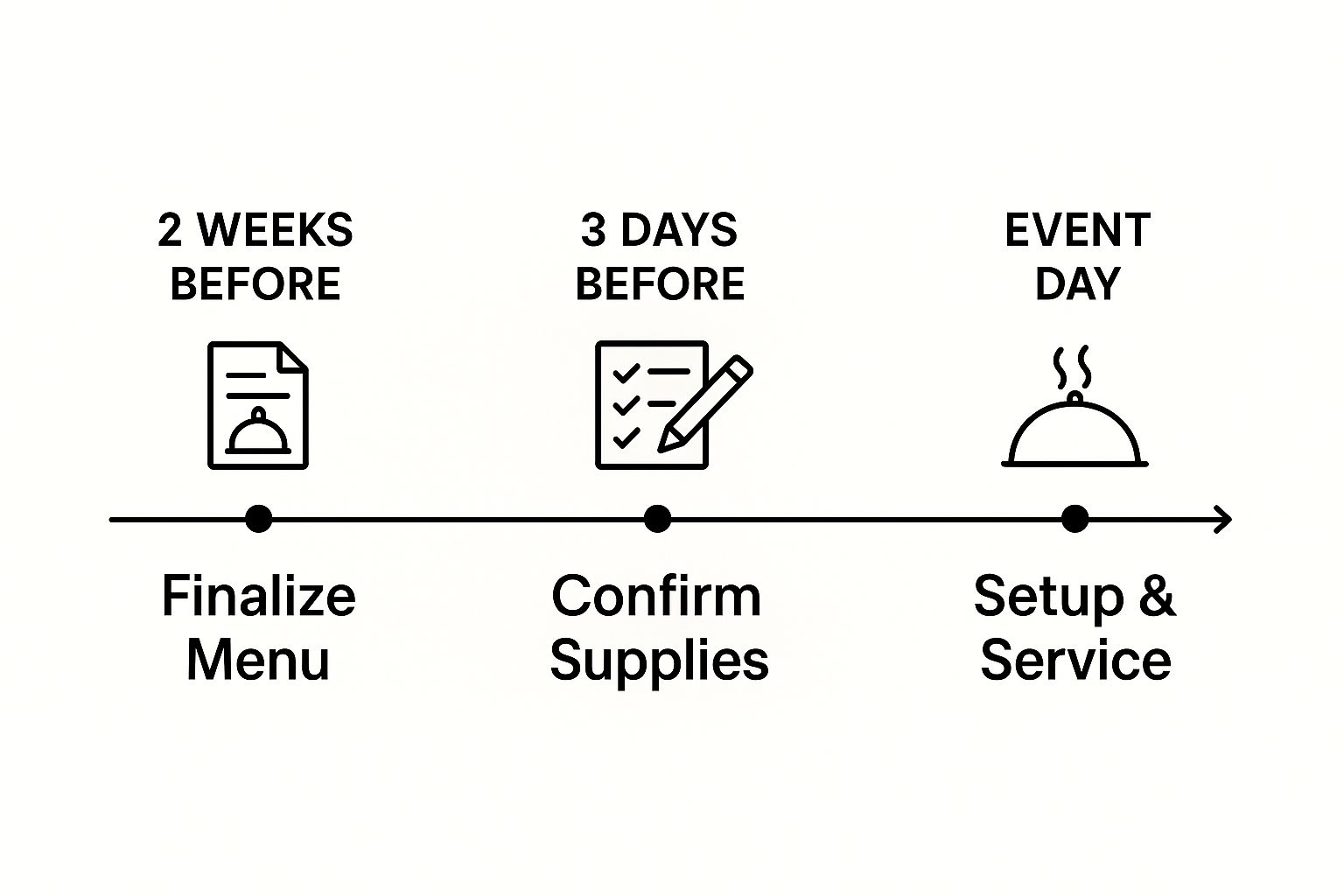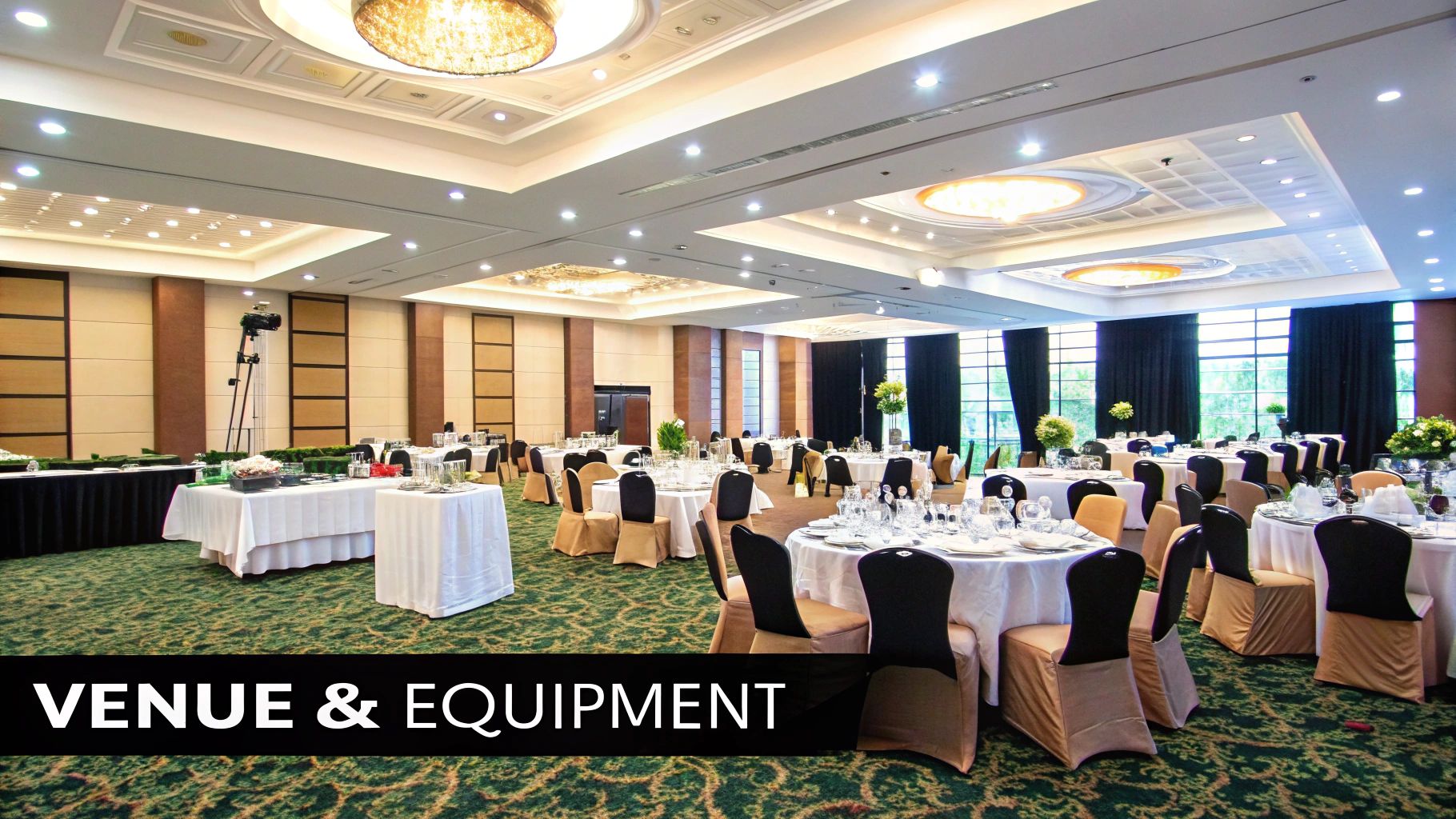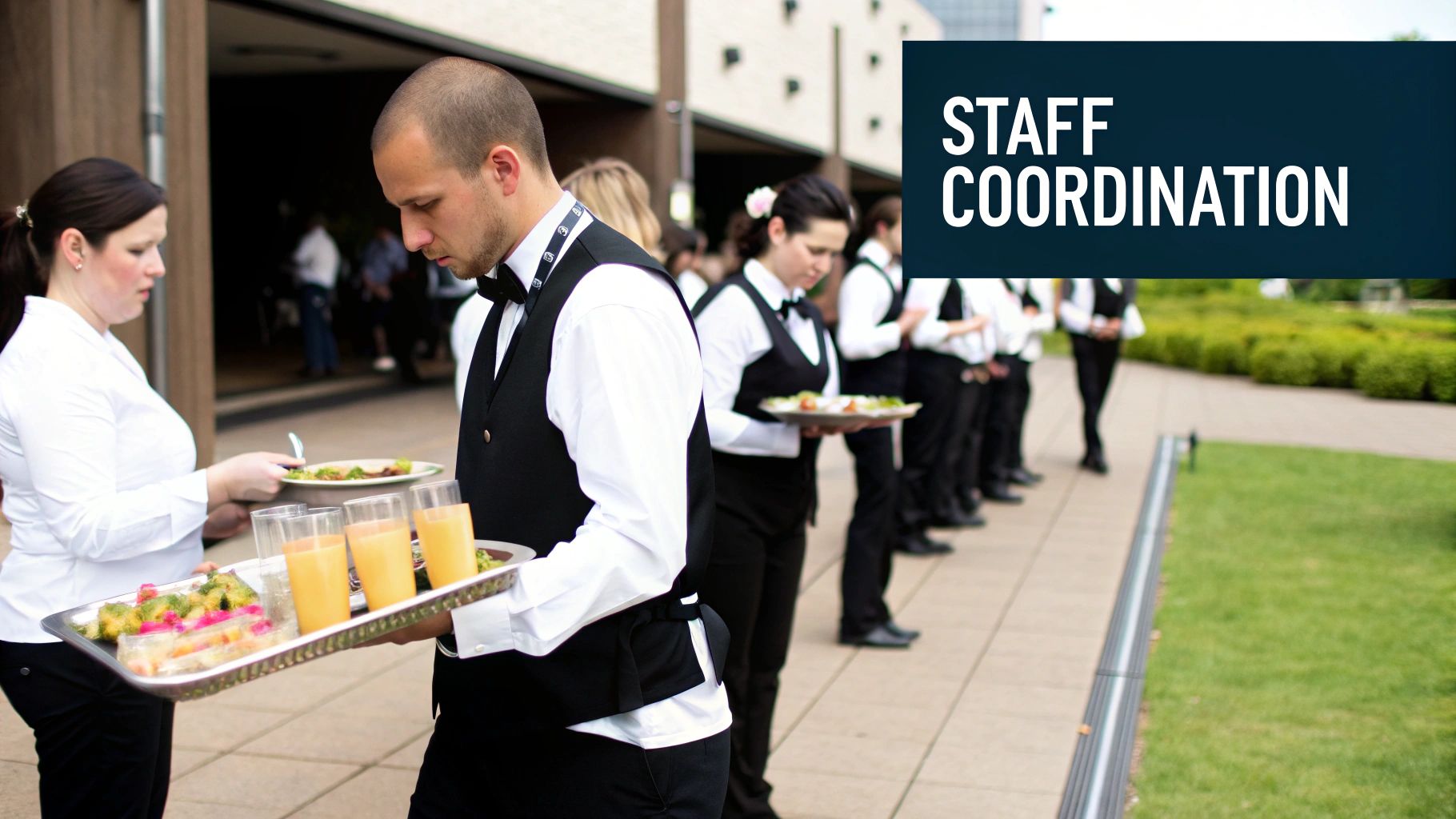Why Your Catering Checklist Can Make or Break Everything
Let’s be honest: a single catering mistake can unravel months of careful event planning and damage your professional reputation. It’s easy to think of a catering checklist as just another to-do list, but it’s much more than that. Think of it as your safety net in a high-pressure environment—the one document standing between a smooth event and a total disaster.
The Hidden Costs of Poor Planning
Even the most experienced planners can be caught off guard by unexpected costs and last-minute problems. A generic template won’t help you when a key vendor suddenly cancels or a guest has a severe allergic reaction to an undeclared ingredient. I’ve personally seen events go sideways because of small oversights that a detailed checklist would have easily caught.
For instance, forgetting to confirm the power requirements for food warmers can result in cold meals and disappointed guests. Not having enough staff for a plated dinner service can cause long delays and frustration. These aren’t just small hiccups; they’re the kinds of failures that can harm your reputation. The difference between a wedding remembered for its perfect meal and one known for its calamari shortage often boils down to thorough documentation.
Why Your Checklist Is Your Best Defense
A well-made catering checklist does more than just keep track of tasks; it also offers a huge psychological advantage. It helps you shift from being stressed and reactive to feeling prepared and in control. As the catering industry continues to grow—reaching a market size of USD 154.71 billion in 2024—so do client expectations and competition.
Having every detail planned out, from specific dietary restrictions to the exact types of disposable catering supplies required, is your best strategy against chaos. This organized approach ensures no detail is overlooked.
Foundation Planning That Prevents Last-Minute Chaos
Before your mind wanders to menus and appetizers, it’s worth remembering that the real success of your event is decided long before the first dish is served. The foundational planning stages are where you lay the groundwork that prevents those all-too-common last-minute disasters. Ask any seasoned planner, and they’ll tell you this early phase is everything.
Nailing the Numbers and Location
Getting an accurate guest count can feel like trying to hit a moving target, but it’s the cornerstone of your entire plan. A huge part of avoiding last-minute chaos is mastering the Save the Date and RSVP process. Here’s a pro tip I’ve learned over the years: always plan for a 5-10% buffer on your final guest count. This simple strategy can save you from the nightmare of running out of food or chairs.
Your venue choice directly impacts your catering success. Before you sign any contracts, you need to ask some practical questions:
- Is there a dedicated catering prep area with enough power outlets and running water?
- What are the restrictions on setup and breakdown times?
- Are there exclusive vendor agreements you have to follow?
I once catered an event at a historic barn that looked stunning but had only two power outlets for the entire catering team. We spent the day juggling food warmers and coffee makers—a stressful situation a simple site visit could have easily prevented.
Timing, Supplies, and Communication
Creating a detailed timeline is non-negotiable for a smooth operation. When you can visualize the key deadlines, it helps keep everyone on your team and your vendors on track and accountable.
To help you get started, here’s a sample timeline that outlines the key milestones and who’s responsible for what.
Event Planning Timeline: Key Milestones
| Timeline | Task Category | Specific Actions | Responsible Party |
|---|---|---|---|
| 6-12 Months Out | Initial Planning | Define event goals, budget, and guest list. Research and book the venue. | Event Planner/Client |
| 4-6 Months Out | Vendor Selection | Research and hire the caterer. Finalize the photographer, entertainment, etc. | Event Planner/Client |
| 2-3 Months Out | Menu & Logistics | Finalize the menu with the caterer. Discuss dietary needs. Plan rentals (tables, linens). | Event Planner & Caterer |
| 1 Month Out | Final Counts | Send final RSVP reminders. Give a near-final guest count to the caterer. | Client |
| 2 Weeks Out | Final Confirmation | Provide the final guaranteed guest count. Confirm delivery/setup times. | Event Planner/Client |
| 1 Week Out | Last-Minute Details | Confirm final floor plan. Share the timeline with all vendors. Check the inventory of supplies. | Event Planner & Caterer |
| Event Day | Execution | Manage vendor arrivals and setup. Oversee event flow and service. | Event Planner & Caterer |
This timeline shows that a structured approach is essential. Making firm decisions well before the event day gives your team the time it needs to execute flawlessly.
A key part of this is building out your catering checklist to ensure you have all your supplies ready. Finally, establish a clear communication plan with your client and vendors from day one. This helps manage expectations and address things like dietary restrictions early, preventing menu chaos down the line.
Menu Planning That Actually Satisfies Everyone
Putting together a menu is more than just picking out tasty dishes; it’s about crafting an experience. A great menu finds the sweet spot between crowd-pleasing staples and a few more interesting options, making sure there’s something for every palate without sending your kitchen into a panic. Your catering checklist needs a dedicated section for this, moving beyond a simple food list to a thoughtful plan for delighting a diverse group.
Imagine you’re catering a corporate luncheon. You could build your menu around a classic grilled chicken entree and a versatile pasta salad. To add a modern touch and accommodate different dietary preferences, you might include a quinoa bowl with roasted vegetables and a lemon-tahini dressing. This strategy satisfies the majority while also impressing guests who appreciate contemporary, health-conscious choices.
Handling Dietary Needs with Grace
Dealing with dietary restrictions and allergies is a standard part of event planning now, not an afterthought. The goal is to manage these needs smoothly, without making any guest feel like they’re an inconvenience. Instead of preparing completely separate (and sometimes less exciting) meals, focus on making your main dishes flexible.
Here are a few practical ways to do this:
- Set up build-your-own stations: A taco bar, a loaded baked potato station, or a pasta bar lets guests customize their plates, easily avoiding ingredients they can’t or don’t want to eat.
- Serve sauces and dressings on the side: This simple adjustment can make many dishes instantly suitable for guests who are avoiding gluten or dairy.
- Use clear, attractive labels: Neatly label each dish, noting if it is vegan, gluten-free, or contains common allergens like nuts. This empowers guests to make their own informed and safe choices with confidence.
Sourcing and Portioning for Success
A memorable menu begins with quality ingredients. Forging relationships with local suppliers can give you access to fresher, seasonal produce that makes your food stand out, and it can even be a cost-effective choice. It’s always smart to have a backup plan for your star ingredients, just in case of supply chain hiccups.
Getting the portion sizes right is just as important. A good rule of thumb is to plan for about 1.25 lbs of food per person in total, but you’ll want to tweak this number based on the event’s timing, duration, and service style. The catering industry is also seeing a growing interest in unique cuisines and specific dietary accommodations, making careful planning and food safety more important than ever.
Choosing Vendors Who Won’t Let You Down
The quality of your food is a big deal, but a caterer’s reliability under pressure is what truly separates a professional from an amateur. Your catering checklist needs a serious vetting process because the partner you select can make or break your entire event. This goes way beyond taste tests; it’s about seeing how they react when things don’t go according to plan.
Vetting for Real-World Scenarios
When you’re interviewing potential caterers, you need to dig deeper than their sample menus. Ask pointed questions that get to the heart of their problem-solving skills. I always like to ask, “Can you describe a time when a key ingredient was unavailable at the last minute, and how you adapted?” Their answer reveals more about their resourcefulness than any tasting session ever could.
Another fantastic question is, “What’s your communication plan if our guest count unexpectedly increases by 15% on the day of the event?” You’re looking for flexibility and a collaborative spirit. A caterer who seems rigid or resists reasonable adjustments during these initial chats could become a major headache later. Remember, you’re not just hiring someone to cook; you’re partnering with a logistics expert who must perform flawlessly when it counts.
To systematically compare your options, a weighted evaluation table can be a lifesaver. It helps you move beyond a gut feeling and objectively score each vendor on the factors that matter most to you.
A Complete Catering Checklist for Evaluating Vendors
| Criteria | Weight (1-5) | Evaluation Questions | Scoring Scale (1-5) |
|---|---|---|---|
| Experience & Reputation | 5 | How many events similar to ours have they handled? Can they provide recent, relevant references? What do online reviews say? | 1: No relevant experience; 5: Extensive, proven track record with glowing reviews. |
| Menu Quality & Flexibility | 5 | Do they offer creative, high-quality menu options? Are they willing to customize dishes for dietary needs? How was the tasting? | 1: Rigid, uninspired menu; 5: Delicious, creative, and highly adaptable menu. |
| Problem-Solving Skills | 4 | How did they answer scenario-based questions? Do they have clear contingency plans for common issues? | 1: Vague or panicked responses; 5: Confident, clear, and proactive solutions. |
| Professionalism & Communication | 4 | Are they responsive, clear, and professional in their communications? Is the contract detailed and transparent? | 1: Slow, unclear communication; 5: Prompt, professional, and transparent. |
| Cost & Value | 3 | Is the pricing transparent and all-inclusive? Does the quoted cost align with the quality and service offered? | 1: Unclear pricing, poor value; 5: Transparent pricing, excellent value. |
This table forces you to think critically about each caterer’s strengths and weaknesses. By assigning a weight to each category, you ensure that the most important factors, like experience and menu quality, have the biggest impact on your final decision.
Decoding Contracts and Spotting Red Flags
When you start getting proposals, it’s time to put on your detective hat. Vague language around staffing levels, potential overtime charges, or contingency plans is a massive red flag. A professional contract will spell out everything in crystal-clear terms, from payment schedules to cancellation policies. Always insist on a clause that details their responsibilities for things like equipment rentals and post-event cleanup.
A refusal to provide references or show proof of insurance should be an immediate deal-breaker. There’s no excuse. A professional caterer will be proud to let you speak with past clients and will understand that liability coverage is non-negotiable. By being thorough in your selection process, you build a foundation of trust that helps ensure your event is a seamless success.
Day of Execution That Runs Like Clockwork
All the planning, lists, and careful organization lead to this single moment: event day. This is where a detailed catering checklist stops being a planning document and becomes your live operational script. Your success now hinges on sharp coordination, clear communication, and the agility to handle the unexpected. Think of it less like a military operation and more like a well-rehearsed theater production where every team member knows their role, their cues, and how to improvise on the fly.
Roles and Communication Protocols
On the day of the event, any confusion is a major problem. Before the first guest even walks in, your team lead should hold a quick huddle to go over the game plan. Everyone, from the servers and bussers to the kitchen staff, needs a totally clear picture of their specific duties and the overall flow of service. For example, assign a single person as the main contact for the client. This prevents them from getting mixed, and often conflicting, requests from multiple team members.
You’ll also need a simple but solid communication system. For bigger events, this might mean using discreet earpieces or a dedicated channel on a messaging app. For smaller gatherings, clear hand signals or designated check-in points can be just as effective. The goal is to have a system that works smoothly under pressure, letting you quickly share updates on everything from refilling appetizers to cleaning up a spill on the dance floor.
Managing Service Flow and Troubleshooting
Keeping food at the right temperature is a massive part of a great event. This is especially true for hot dishes that have to travel from an off-site kitchen to the venue. Once you’re on-site, your checklist should include scheduled temperature checks for buffet items and close coordination between the kitchen and servers for plated meals to ensure food is served promptly.
With the U.S. catering industry pulling in revenues of $72 billion in 2023, client expectations are through the roof. A solid checklist is no longer a “nice-to-have”; it’s critical for managing the complex details that lead to top-quality service. This detailed approach is essential in an industry that has experienced significant growth and is projected to continue expanding. Ultimately, day-of execution is all about proactively managing the small stuff so every guest has a perfect experience, from their first bite to their last.
Learning From Every Event To Improve Your Process
The event isn’t truly over when the last guest leaves. In fact, for the most successful planners, this is when some of the most important work begins. The time immediately following an event is a goldmine for insights, and it’s your best opportunity to turn a good event into a great, repeatable process. Your goal should be to make your catering checklist a living document that gets smarter after every single gig.
Gathering Actionable Feedback
To get feedback that you can actually use, you need to act while memories are still fresh. Don’t just ask your team, “How did it go?” That’s too broad. Instead, ask specific, open-ended questions that encourage detailed answers.
For instance, pulling your lead server aside and asking, “What was the biggest bottleneck during dinner service?” will give you far more useful information than a generic question. The same goes for clients. Instead of “Did you enjoy the food?” try, “Which dish seemed to be the biggest hit with your guests?” For collecting feedback from a larger group, digital survey tools can be incredibly effective for getting structured responses quickly.
This kind of detailed feedback helps you spot patterns. You’ll start to see what parts of your process are rock-solid and which ones need a complete overhaul before the next event.
Updating Your Process
Now, what do you do with all this great information? Document it. If you don’t write it down, it’s easy to forget. Create a dedicated section in your event files for post-event notes. A simple structure with bullet points works wonders:
- What went right: The new mini quiche appetizer was a massive hit; the 1-to-15 staff-to-guest ratio was perfect for this type of seated dinner.
- What went wrong: We ran low on ice an hour into the cocktail reception; our point of contact with the DJ was unclear, causing confusion during announcements.
- Action items: Add “Confirm venue’s ice machine capacity or order supplemental ice” to the pre-event checklist. Establish a single, named point of contact with all outside entertainment vendors.
Thinking about your internal operations is just as important. As you review notes from past events, you might notice that managing payments and receipts is becoming a time sink.
By consistently refining your catering checklist and procedures, you’re not just planning one-off events; you’re building a reliable, intelligent system. This ensures every future client benefits from the full depth of your experience. For all your event needs, from elegant containers to practical disposables, explore the wide selection at MrTakeOutBags.com.




